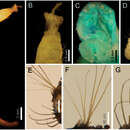Description
(
英語
)
由Zookeys提供
Holotype (LACM-AHF2594), without posterior end, soft, whitish (Fig. 6A). Body club-shaped, anteriorly swollen, progressively narrowing to chaetiger 15, then cylindrical, tapering to the end of the fragment; 19 mm long, 2 mm wide, cephalic cage 1.5 mm long, 47 chaetigers. Tunic papillated, fine sediment particles on papillae basis only. Papillae short, abundant, capitate, with basal sediment making a rounded lobe, about 13–15 irregular rows in anterior chaetigers (about 10 rows in median chaetigers), slightly longer dorsally and in posterior chaetigers; in median chaetigers papillae as long as 1/5–1/6 notochaetal length. Anterior end completely exposed, slightly damaged (Fig. 6B). Cephalic hood short, smooth, margin smooth. Prostomium low, pale, eyes not seen. Caruncle poorly developed, lateral ridges low, median keel reduced, not continued to the posterior margin of the branchial plate (Fig. 6C). Palps lost in holotype (pale in one paratype), palp bases rounded. Lateral lips well developed, dorsal lip reduced, ventral lip rounded. Branchiae mostly lost, branchial scars on branchial plate, arranged in two rows, posterior row with 4 thicker branchial scars, anterior row discontinuous, two narrower branchial scars, one long cirriform branchia left. Nephridial lobes rounded, separating posterior and anterior branchiae. Cephalic cage chaetae shorter than body width. Chaetiger 1 involved in the cephalic cage, slightly displaced dorsally; chaetae arranged in short dorsolateral lines, with 2 noto- and 4 (–6) neurochaetae. Anterior dorsal margin of first chaetiger papillated; anterior chaetigers without especially long papillae. Chaetigers 1–3 progressively larger. No chaetal transition from cephalic cage to body chaetae, all neurochaetae similar, but first chaetiger with shorter articles. Gonopodial lobes present in chaetiger 5 (or 5 and 6 in some paratypes), a transverse papillae-free area. Parapodia lateral, poorly-developed, chaetae emerge from the body wall (Fig. 6E); median neuropodia ventrolateral. Notopodia without conical chaetal lobes. Noto- and neuropodia distant to each other. Median notochaetae arranged in a longitudinal, short line; all notochaetae multiarticulated capillaries, short articles basally, long medially and distally (Fig. 6F). About 6–8 chaetae per bundle, 1/2–2/3 as long as body width. All neurochaetae multiarticulated hooks, feebly-defined short articles basally, medial- and distally with long articles, distally falcate (Fig. 6G); neurohooks arranged in a transverse line, with 5–6 per bundle. Posterior end (observed in a paratype) tapering to a rounded lobe (Fig. 6D); pygidium with anus terminodorsal, without anal cirri.
- 許可
- cc-by-3.0
- 版權
- Sergio I. Salazar-Vallejo, Galina Buzhinskaja
- 書目引用
- Salazar-Vallejo S, Buzhinskaja G (2011) Revision of Diplocirrus Haase, 1915, including Bradiella Rullier, 1965, and Diversibranchius Buzhinskaja, 1993 (Polychaeta, Flabelligeridae) ZooKeys 106: 1–45
- 作者
- Sergio I. Salazar-Vallejo
- 作者
- Galina Buzhinskaja
Distribution
(
英語
)
由Zookeys提供
Western Mexico, in both sides of the Baja California Peninsula, in subtidal waters.
- 許可
- cc-by-3.0
- 版權
- Sergio I. Salazar-Vallejo, Galina Buzhinskaja
- 書目引用
- Salazar-Vallejo S, Buzhinskaja G (2011) Revision of Diplocirrus Haase, 1915, including Bradiella Rullier, 1965, and Diversibranchius Buzhinskaja, 1993 (Polychaeta, Flabelligeridae) ZooKeys 106: 1–45
- 作者
- Sergio I. Salazar-Vallejo
- 作者
- Galina Buzhinskaja

